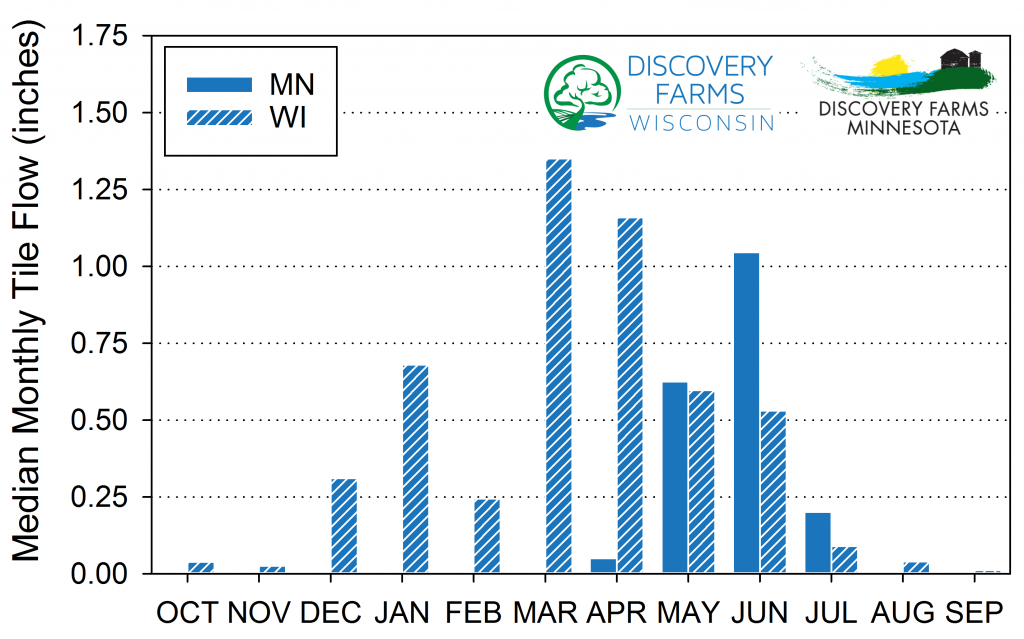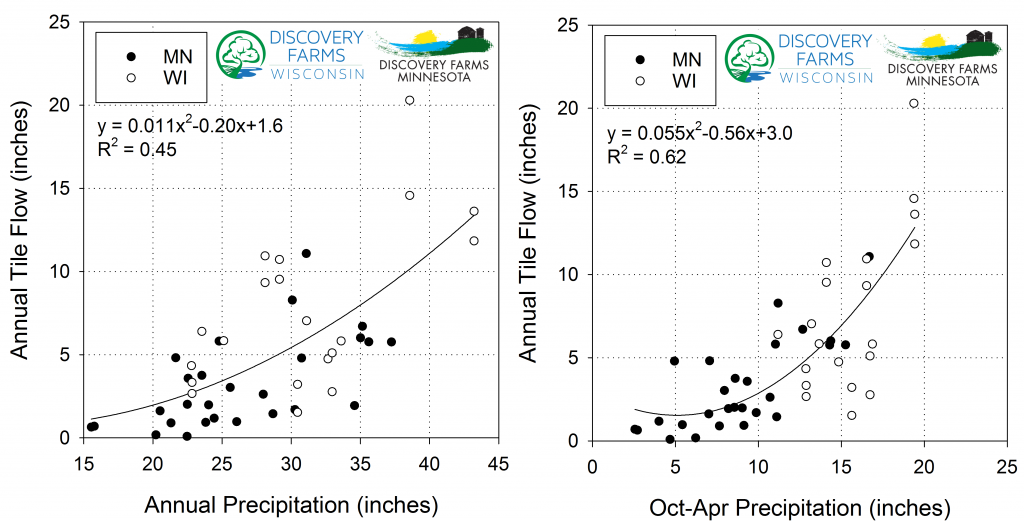Wisconsin and Minnesota Discovery Farms have collected tile drainage data from a wide variety of farming systems. Combining these datasets provides an enhanced assessment that neither state could accomplish individually. This more comprehensive dataset can help draw more conclusions and recommendations about how tile systems influence water quality.
Tile water quality information has been collected from 10 different farms and 14 fields starting in 2005. In total, Discovery Farms has 47 site years of data. The fields are very diverse with slopes ranging from less than 1 to 5%. Soils range from fine sandy loams to clay loams and there are both random and pattern tile lines in the dataset. Monitored fields include corn, soybean, alfalfa, sugarbeet, wheat, and pasture. There are several clear lessons learned about soil and nutrient loss from tile systems but the first piece to understand is tile flow quantity and timing.
There is typically more tile flow than surface runoff on an annual basis.
Surface runoff and tile flow typically range from 1.3 to 4.2 and 1.8 to 6.5 inches, respectively (Figure 1). There are also differences between the timing and intensity of surface runoff and tile flow. Surface runoff is often inconsistent but generally occurs during snowmelt in the early spring and during the time from planting to crop canopy. On average, there are 10 days of surface runoff per year. On the other hand, tile drainage has many more days of flow and is much more consistent throughout the year.

The amount and timing of tile flow differs between Wisconsin and Minnesota.
While surface runoff characteristics in Minnesota and Wisconsin were similar, the amount of tile flow was higher in Wisconsin compared to Minnesota. 23% of precipitation moved through tile in Wisconsin compared to 9% in Minnesota. There were also many more days of flow per year in Wisconsin compared to Minnesota tile sites.
The flow time period in Wisconsin is typically from December through July, whereas in Minnesota it is typically from April through July (Figure 2). In Wisconsin, there was a significant portion of tile flow during the frozen ground period. The difference in the amount and timing of drainage is likely due to climate and landscape position. The Wisconsin sites usually have much more rainfall during the October through April time period. Three of the Wisconsin sites were located in low areas in the landscape that were influenced by shallow groundwater flow.

Precipitation between Minnesota and Wisconsin likely explains some of the differences in the amount of tile flow observed between the two states.
The amount of precipitation during the year has a large effect on the amount of tile flow. There is a strong correlation between annual precipitation and annual tile flow (Figure 3). There is even a stronger correlation between October through April precipitation and annual tile flow (Figure 4). Precipitation during this period has a significant impact on the amount of tile flow. Precipitation differences between Minnesota and Wisconsin likely explain the differences in the amount of flow observed between the two states. During the years monitored in Minnesota and Wisconsin, Wisconsin had more than 7 inches of additional precipitation during the October through April period. This is not unique to the years monitored. Looking at long term 30-year precipitation normal for the monitored sites, the Wisconsin sites have 3.8 inches more during the October through April time period.

More tile information to come at Discovery Farms Conference and through new research.
The 2016 UW Discovery Farms Annual Conference will feature a talk on tile. The presentation will continue to dive into the comprehensive dataset from Minnesota and Wisconsin Discovery Farm and offer three practical ways to avoid losing soil, nitrogen, and phosphorus from tile drains. For details on the conference and a sneak peek of the agenda click here.
The Minnesota and Wisconsin Discovery Farms Programs have recently received a Conservation Innovation Grant (CIG) from the United States Department of Agriculture – Natural Resources Conservation Service (USDA-NRCS) for “Developing Diagnostics to Improve Water Quality and Soil Health on Tile Drained Lands in Minnesota and Wisconsin.” This grant will allow Discovery Farms Programs in both states to continue efforts to identify the timing and mechanisms of soil and nutrient loss to tile drainage systems. For more information about the project click here and visit the USDA-NRCS website to read more about the 45 innovative award winners.
This article originally appeared in the latest UW Discovery Farms newsletter. If you would like to read more from the newsletter please click here.
- Lessons Learned from Schafer Farms – Implementing Conservation in a Rolling Landscape - April 8, 2020
- What happened to spring? - July 15, 2019
- Tile flow and nutrient movement in Northwest Minnesota - September 13, 2018